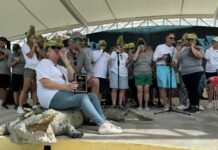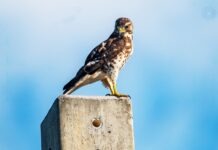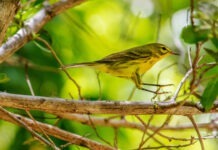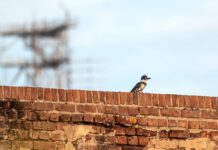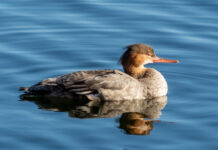
I guess I’ve seen flycatchers that you could call swashbuckling. The gray kingbirds that will be returning over the next few weeks to stake out their territories and perch on utility wires for the summer have shown themselves to be fearless adventurers on innumerable occasions, chasing off anything they think might be a threat. Among the many recipients of their aggression are hawks, kestrels, mockingbirds and cats. They have also been known to throw themselves at the occasional dog on a leash trotting next to a newspaper wildlife columnist riding a bicycle, nipping said dog on the butt and sending the dog, trailed by the leash-attached newspaper wildlife columnist, rushing in a full speed panic toward a busy intersection while the attached newspaper wildlife columnist frantically tried to use the badly-in-need-of-tightening hand brake to stop them. (They all survived.)
The similarly swashbuckling, closely related eastern kingbird has been known to have a go at a similar list of encroachers, as well as such offending interlopers as bald men with especially shiny pates and small airplanes flying too low for their liking.
I’d never had a chance to see a kingbird with piratic tendencies in North America, though, until this weekend, when I saw a piratic flycatcher at the Key West Botanical Garden.
The piratic flycatcher is an inhabitant of Central America and northern South America, though there are just short of a dozen records of it north of the Mexico line, making it a Category 4 on the American Birding Associations rarity code. This one was found by a visiting birder named Juli DeGrummond.
Oddly enough, a different piratic kingbird was reported at the same time higher up the Florida peninsula at Fort De Soto Park on the Gulf coast. Which perhaps isn’t odd. As noted Florida ornithologist Andy Kratter pointed out, “In Florida we like our vagrants in bunches,” with multiple far-flung, near-simultaneous sightings in recent years of rare species like red-legged honeycreeper, large-billed tern, American flamingo, Cuban pewee, black-faced grassquit, and red-legged thrush.
For some of these rarities – the American flamingos and the red-legged honeycreepers – their arrival can be tied to storms and other weather patterns with a high degree of confidence. But in most cases, it is usually more ambiguous.
Whenever a rare bird shows up, birders generally ask the same questions, the first one being: is it an escaped pet? If the species is sold in pet shops or popular in the illegal bird trade, a state records committee might not accept a sighting. For instance, sightings of two red-legged honeycreepers seen in Key West and at the Dry Tortugas in 2003 were rejected because it was possible to buy a red-legged honeycreeper in a pet store. It didn’t matter that the nearest pet store that sold them was on the mainland, over 150 miles away, and that they could be found in their natural habitat in Cuba only 90 miles away. (Interestingly, after multiple red-legged honeycreepers came into multiple spots in Florida, Louisiana and Texas in 2022, the 2003 records were retroactively accepted.)
Nobody really worried about the piratic being a caged bird. Like the gray kingbird and the eastern kingbird it is a member of the tyrant kingbird family, and would most likely be too aggressive to do well, or even survive, in a cage. Also, though the species has a distinctive thick black eyestripe across its mostly white face, it’s not a particularly beautiful or exotic looking bird, not the kind of bird that people look at and think, Ooh, I need to keep that one in my living room.
It’s a little bit of a letdown that the piratic flycatcher’s name does not derive from any physical attribute. There is, sadly, no eye patch or red bandana. And its call sounds nothing like “arrgggh” or “matey,” or anything remotely nautical. The name comes from the fact that they don’t build their own nests, but instead abuse and harass other birds into leaving theirs, and then move in, tossing out any eggs the previous tenants may have left behind.
The other main question birders ask when a rarity from across a large body of water appears is, was it ship-aided? Did it ride rather than fly? It’s almost a purely academic question, largely because there is no real way to know, and even if it was known, the ABA considers a ship-aided bird to be a countable bird on the checklists of those who keep score.
When I made it to the Botanical Garden on Sunday it was almost, at first, a repeat of the scene with the pearly-eyed thrasher two weeks before. I once again ran into Mark Whiteside in the parking lot, and inside the gates, we once again ran into Matthew Jolley, who told us he’d just seen the bird in the gumbo limbo tree on a branch over the pond. But then he left. Mark and I walked around for a bit before we realized there were at least three gumbo limbos with branches out over the pond. I didn’t have Matthew’s number, so I sent a message through a mutual friend asking which gumbo limbo it might be. Five minutes later Matthew showed up and showed us exactly which tree he meant. Which was very nice of him.
The piratic wasn’t in the tree, though. Instead we watched a half-dozen gray catbirds come in and out, some of them softly singing songs they would belt out in full voice in a few weeks once they made it back to their breeding territories. There was also a trio of indigo buntings and a warbler or two.
A trio of broad-winged hawks drifted overhead. Then a trio of short-tailed hawks.
We kept vigil on the gumbo limbo, but then noticed some movement in the tree next door. And boom, there it was, perched as inauspiciously as any tyrant flycatcher I have ever seen.
It gave us a nice long look until Ellen Westbrook texted she was on the way, then it disappeared again. Ellen had missed the pearly-eyed thrasher, so I was slightly worried about a jinx. Amy Grimm arrived from Big Pine and saw it, and a birder from, I think, Texas also saw it while we waited for Ellen.
When Ellen did arrive we all stood there for a while, staring into the gumbo limbo and the neighboring tree, trying to will the flycatcher into appearing. After it didn’t, we spread out, searching through other adjacent bits of foliage without much luck.
I walked up to the front to get a drink from the water fountain and the woman working the desk mentioned they’d be closing in half an hour, so now there was deadline pressure, too.
Occasionally one of us would spot it, but by the time Ellen got there it moved. This happened three or four times. But then I heard Ellen’s voice from the next path over say she got it, and felt a sizable relief.
The micro-jinx was broken. High fives all around. Another rare bird seen in the Florida Keys.




